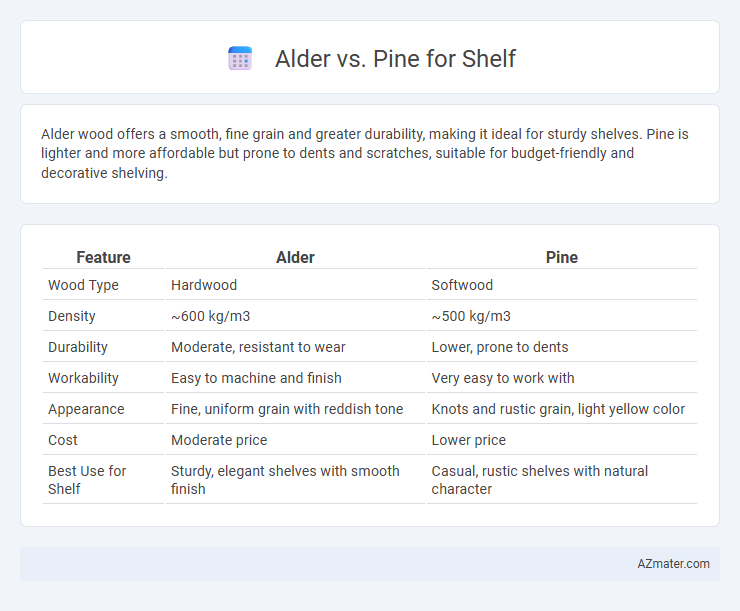Alder wood offers a smooth, fine grain and greater durability, making it ideal for sturdy shelves. Pine is lighter and more affordable but prone to dents and scratches, suitable for budget-friendly and decorative shelving.
Table of Comparison
| Feature | Alder | Pine |
|---|---|---|
| Wood Type | Hardwood | Softwood |
| Density | ~600 kg/m3 | ~500 kg/m3 |
| Durability | Moderate, resistant to wear | Lower, prone to dents |
| Workability | Easy to machine and finish | Very easy to work with |
| Appearance | Fine, uniform grain with reddish tone | Knots and rustic grain, light yellow color |
| Cost | Moderate price | Lower price |
| Best Use for Shelf | Sturdy, elegant shelves with smooth finish | Casual, rustic shelves with natural character |
Overview: Alder vs Pine for Shelving
Alder and pine both offer unique benefits for shelving, with alder being a hardwood known for its fine grain, durability, and rich, reddish-brown color that darkens over time, making it ideal for high-end furniture and shelves requiring a smooth finish. Pine is a softwood characterized by its lighter color, prominent knots, and affordability, providing a rustic, natural look suited for casual or farmhouse styles. While alder provides greater strength and resistance to dents, pine is easier to work with and widely available, making it a popular choice for budget-friendly shelving projects.
Wood Characteristics: Alder and Pine Compared
Alder wood is known for its fine, even texture and smooth grain, making it ideal for creating sleek, polished shelves with a natural reddish-brown hue. Pine features a lighter color with prominent knots and a softer texture, offering a rustic, casual aesthetic but is more prone to dents and scratches due to its lower hardness. Both woods are relatively lightweight and easy to work with, though alder provides greater durability and a more consistent finish compared to pine's distinctive, varied grain pattern.
Strength and Durability: Which Wood Lasts Longer?
Alder wood offers moderate strength and durability, making it suitable for indoor shelves that experience light to moderate use. Pine is generally softer and less dense than alder, leading to a higher risk of dents and scratches over time, which can affect shelf longevity. For projects requiring longer-lasting shelves with better resistance to wear, alder is typically the preferred choice due to its harder grain and greater structural stability.
Workability: Ease of Cutting and Shaping
Alder wood is highly favored for shelf workability due to its soft texture, allowing smooth cutting and effortless shaping with hand tools and power equipment. Pine offers moderate workability and can sometimes splinter during intricate cuts, requiring sharper blades and more careful handling. Both woods respond well to sanding and finishing, but alder's fine grain enhances precision in detailed shelf designs.
Aesthetic Appeal: Grain Patterns and Colors
Alder wood features a smooth grain with subtle, uniform patterns and a warm, reddish-brown hue that deepens over time, offering a refined and elegant aesthetic for shelves. Pine displays a more prominent, knotty grain with a lighter, yellowish tone, creating a rustic and casual look often favored in country or cabin-style interiors. Choosing between alder and pine shelves depends on whether a sleek, sophisticated appearance or a natural, textured appeal is desired.
Cost Comparison: Alder vs Pine Shelves
Alder shelves typically cost more than pine shelves due to alder's finer grain and richer color, which offer a more polished aesthetic. Pine shelves are generally more affordable, making them a popular choice for budget-conscious projects while still providing good durability for everyday use. Choosing between alder and pine involves balancing cost with desired appearance and long-term wear.
Weight Capacity: Supporting Your Items
Alder wood shelves offer a moderate weight capacity, supporting everyday items like books and decorative pieces efficiently due to its fine grain and medium density. Pine shelves, being softer and lighter, have a lower weight capacity, making them ideal for lighter items or less frequently used storage. Choosing alder ensures greater durability and support for heavier objects, while pine provides an economical option for lighter loads.
Finishing Options: Stains, Paints, and Sealants
Alder wood offers excellent compatibility with a wide range of stains, enhancing its natural grain with warm amber and reddish tones, while pine tends to absorb stains unevenly due to its resin pockets, often resulting in blotchy finishes. Paint adheres well on both alder and pine shelves, but pine's softer texture may require more surface preparation like sanding or priming to ensure a smooth, durable coating. Sealants such as polyurethane or lacquer provide durable protection for alder shelves, preserving their rich appearance, whereas pine shelves benefit from sealants that offer enhanced moisture resistance to prevent warping and surface damage.
Environmental Impact: Sustainability of Alder and Pine
Alder wood is considered more sustainable than pine due to its faster growth rate and higher carbon sequestration capacity, which helps reduce environmental impact. Pine is widely available and grows quickly, but some species require intensive management practices that may affect biodiversity. Choosing alder for shelving supports sustainable forestry by promoting regeneration and maintaining ecosystem balance.
Best Applications: When to Choose Alder or Pine for Shelves
Alder wood is ideal for shelves requiring a smooth finish and warmer tone, often chosen for cabinets and high-end furniture due to its fine grain and stability. Pine shelves suit rustic or budget-friendly projects, offering a lighter color and softer texture that is easy to work with but may dent more easily. Choose alder for durability and refined aesthetics, while pine is best for casual, lightweight storage solutions or decorative shelving.

Infographic: Alder vs Pine for Shelf
 azmater.com
azmater.com